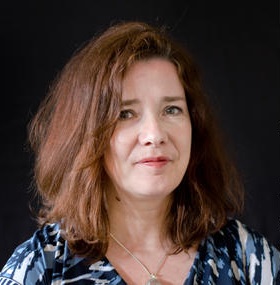Catriona MacLeod acknowledges that German literature and aesthetics seem an unlikely professional focus for a scholar whose first language was Scottish Gaelic. A native of Scotland’s Outer Hebrides Islands and now a professor of German and the Edmund J. and Louise W. Kahn Professor in the Humanities, MacLeod says visits to her mother’s homeland bridged the cultural divide.
“I spent a good deal of time in Germany as a girl and as a teenager, and gravitated to museums,” she explains. “At 19 and 20, I was reading Goethe and Schiller for all I was worth. As an undergrad majoring in German literature at the University of Glasgow, I became enthralled with how, in the 18th and 19th centuries, German writers were thinking about philosophy and German artists were thinking about literature. I wrote Fugitive Objects: Sculpture and Literature in the German Nineteenth Century because although the relationship was being articulated in different places, no one had examined these perspectives in tandem. To provide a true picture of art in the era, I had to go deep into literature, philosophy, and art history, three disciplines with different methodologies and ways of thinking.”
Musing about why sculpture is discussed at length in German literature, yet dismissed as inconsequential, Fugitive Objects discusses its disappearance as a legitimate art form in German aesthetics at the dawn of the 19th century, the demotion of statues from high art to mass production and popular culture, and sculpture’s changing presence in literary discourse. “By the 19th century, sculpture seemed to have lost its prominence among the arts,” MacLeod notes. “It receded from the iconic status it enjoyed in the 18th century, when many writers were obsessed by it.
“Sculpture became incredibly unstable,” she continues. “Napoleon’s state-sanctioned looting of Roman artworks and Vatican collections to establish the Louvre was only one example of destruction and theft coinciding with major political crises. European powers competed with one another to acquire other nations’ treasures and antiquities. Alma Clooney is even now making the case that the Elgin Marbles be returned to Greece, where these ancient sculptures originally adorned the Parthenon.”
Political ambitions and the realities of war damaged and destroyed many irreplaceable pieces. French poet Charles Baudelaire described sculpture as “boring” and “brutal,” and German intellectuals Schiller and Goethe decried the diminution of their work by the mass production of lesser forms in smaller formats and less refined materials. MacLeod’s original readings of German and German-speaking novelists, poets, and philosophers confirm that sculpture, though disregarded by much of 19th-century German literature and aesthetics, “lurked around the edges” in literature, and came back to prominence with Rodin.
Glancing at the bust of Goethe on her mantle, the 2011 recipient of the Ira H. Abrams Memorial Award for Distinguished Teaching summarizes her book’s anticipated contribution to the existing body of knowledge about this intriguing period: “Fugitive Objects makes its most significant contribution, I think, by interpreting canonical works of literature within their wider artistic and historical context.”



